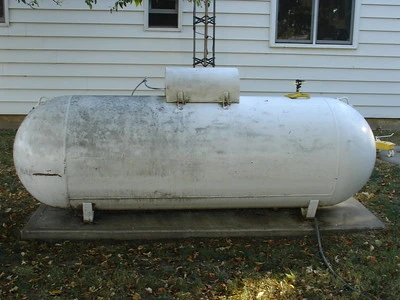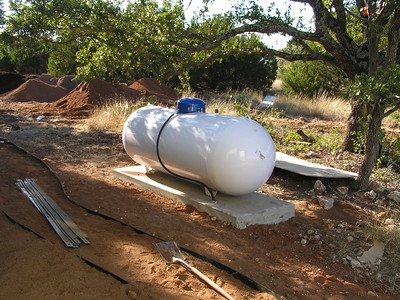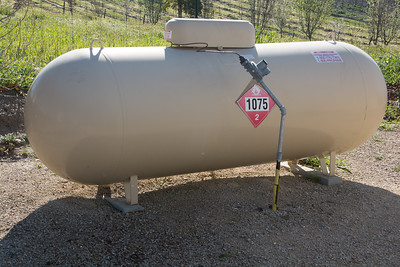
If you have a 500-gallon propane tank or are thinking about getting one, you might be wondering how close it can be to your house. It’s an important question because keeping the right distance isn’t just about following the rules—it’s also about making sure your home and family stay safe.
In this article, we’ll break down why this distance matters and what you need to know to get it right.
Understanding the Basics
What Is a 500-Gallon Propane Tank?
A 500-gallon propane tank is a large container that holds propane gas, which is used for things like heating your home, running appliances like stoves and water heaters, and even powering generators. This size tank can hold up to 400 gallons of propane when it’s 80% full (which is standard for safety). It’s a popular choice for many homeowners because it can usually last for several months before needing a refill, making it convenient for everyday use.
This size of propane tank is commonly found in homes that use propane as a primary fuel source, especially in areas where natural gas isn’t available. It’s big enough to support most household needs, whether you’re using it for heating in the winter, cooking throughout the year, or even running appliances like clothes dryers. Many people choose a 500-gallon tank because it strikes a good balance between capacity and the space it takes up in the yard.
Minimum Distance Requirements
General Rule for Placement
In the U.S., the standard rule is that a 500-gallon propane tank should be at least 10 feet away from your house. This rule is based on safety regulations to reduce the risk of fire or explosion. The distance helps ensure that if something goes wrong, like a leak or a fire, your home is less likely to be affected.
These rules come from the National Fire Protection Association (NFPA) and are followed by local building codes. So, by keeping your tank at least 10 feet away, you’re not only keeping your home safer but also making sure you’re following the law. If you’re unsure about the exact requirements for your area, it’s a good idea to check with local authorities or a propane professional.
Why the 10-Foot Rule Keeps Your Home Safe:
- Reduces Fire Risk: If there’s ever a fire, having the tank 10 feet away from your house gives firefighters time to respond without the fire spreading quickly to your home.
- Prevents Explosions: In the rare case of a propane leak, having the tank at a distance lowers the chance that gas will accumulate near your house, reducing the risk of an explosion.
- Follows Legal Regulations: The 10-foot rule isn’t just a suggestion—it’s part of the National Fire Protection Association (NFPA) guidelines and is enforced by local laws across the U.S. By following this rule, you’re staying within the law and avoiding potential fines.
- Allows for Safe Maintenance: Keeping the tank at a proper distance provides enough space for propane professionals to safely perform maintenance or refilling without getting too close to your house.
- Protects Against Accidental Damage: The distance also helps prevent accidents, like a vehicle hitting the tank or other unexpected incidents that could be more dangerous if the tank were too close to your home.
By keeping these points in mind, you’re ensuring that your propane tank is not only positioned safely but also in line with U.S. laws and regulations.
Exceptions and Variations
Local Codes and Regulations
While the general rule is to keep your 500-gallon propane tank at least 10 feet away from your house, some areas might have stricter rules. For example, certain local codes or regulations could require a greater distance, like 15 or even 25 feet, depending on where you live. These rules can vary based on factors like how densely populated your area is or specific safety concerns in your region.
It’s always a good idea to double-check with your local authorities or a propane professional to make sure you’re following the right rules for your area. This way, you can avoid any surprises and ensure that your propane tank placement is both safe and compliant with all the necessary regulations.
In some cases, local fire departments or building inspectors may have additional requirements that go beyond the national guidelines. For example, if your property is in a high-risk area for wildfires or if your neighborhood has unique zoning laws, the distance requirements might be stricter. It’s also possible that certain insurance companies may have their own rules about how far your propane tank should be from your house.
To avoid any issues, it’s best to contact your local zoning office or fire department before installing your propane tank. A quick call or visit can save you from potential fines or having to move the tank later on. If you’re ever in doubt, a licensed propane professional can help you navigate these regulations and ensure that your tank is placed in the safest and most compliant location.
Why Distance Matters
Safety Concerns
Keeping your 500-gallon propane tank at least 10 feet away from your house isn’t just about following rules—it’s about protecting your home and family from potential dangers.
Here’s why that distance is so important:
1. Preventing Fires:
- Explanation: Propane is a flammable gas, and if a fire were to occur near the tank, the heat could cause the propane inside to expand. If the tank is too close to your house, the fire could easily spread to your home, causing more damage. The 10-foot rule helps create a safe buffer zone. This distance provides enough space for firefighters to respond to the situation without the flames quickly jumping from the tank to your home. The NFPA (National Fire Protection Association) sets this standard to reduce the risk of fire-related incidents involving propane tanks.
2. Avoiding Leaks:
- Explanation: Propane leaks, while rare, can happen due to a variety of reasons, such as a faulty valve or a damaged line. If the tank is too close to your home, leaking propane gas could collect around the house, especially in low areas like basements or crawl spaces. Since propane is heavier than air, it can accumulate in these spots, posing a serious risk if it comes into contact with a spark or open flame. The 10-foot distance allows any leaking gas to disperse into the open air more safely, reducing the likelihood of dangerous gas buildup near your home.
3. Protecting Against Accidents:
- Explanation: Accidents happen, whether it’s a vehicle bumping into the tank, a tree falling during a storm, or some other unexpected event. If the tank is too close to your house, any impact on the tank could potentially damage your home as well. The 10-foot buffer zone acts as a protective barrier, minimizing the chance that an accident involving the tank will also affect your house. For example, if a car accidentally hits the tank, the distance can help prevent the impact from reaching your home’s structure.
4. Meeting Legal Requirements:
- Explanation: Besides safety concerns, maintaining the correct distance ensures that you’re complying with local laws and regulations. The NFPA sets the 10-foot rule, but some areas may require even greater distances. By following these rules, you avoid penalties such as fines, and you also ensure that your tank installation passes inspections. If you don’t follow the regulations, you might be forced to move the tank later, which could be costly and inconvenient. Staying compliant from the start saves you from these potential headaches.
These safety measures might seem simple, but they play a huge role in keeping your home and everyone in it safe from potential hazards associated with propane.
Installation Tips
Choosing the Right Spot
When installing a 500-gallon propane tank, it’s important to find a location that not only meets the distance requirement (at least 10 feet from your house) but is also practical for everyday use. Here are some tips to help you choose the best spot:
- Flat Ground:
- Explanation: Placing your propane tank on flat, stable ground is crucial for safety and proper functioning. A level surface ensures that the tank stays balanced and secure, reducing the risk of tipping or shifting. If the tank is installed on uneven ground, it could lean to one side, which might put extra pressure on the connections and lead to leaks over time. Additionally, a stable base prevents the tank from sinking into the ground during heavy rains or freezing conditions, which could make access difficult.
- Easy Access for Refills:
- Explanation: Your propane tank will need to be refilled periodically, so it’s important to place it in a spot that is easily accessible for delivery trucks. This means choosing a location that is clear of obstacles, such as fences, trees, or other structures that could block the path. Ensuring easy access helps the delivery driver reach your tank without difficulty, which makes the refill process quicker and safer. Also, consider the weather conditions—placing the tank on a path that stays clear of snow or mud will make refills easier year-round.
- Convenience for You:
- Explanation: While safety and access are key, you’ll also want to place the tank in a spot that’s convenient for your everyday needs. For example, you might want to keep it out of sight from your main living areas or garden for aesthetic reasons. However, make sure it’s still close enough to your home’s propane appliances to minimize the length of gas lines. Longer lines can lead to more pressure drops and potential issues. Finding the right balance between convenience and safety is key.
- Considering Future Maintenance:
- Explanation: Think ahead about the maintenance your tank might need in the future. Placing the tank in an open area allows for easy inspections, repairs, or even tank replacement if needed. Avoid tight spaces or areas that could become difficult to access over time due to overgrown vegetation or new construction. Keeping the area around the tank clear also helps reduce the risk of accidents, like a branch falling on the tank or someone tripping over the gas lines.
- Adhering to Local Regulations:
- Explanation: Lastly, remember that local regulations might have additional requirements beyond the 10-foot rule, such as keeping the tank a certain distance from property lines, driveways, or other structures. When choosing the right spot, make sure you’re also following these guidelines. If you’re unsure, consulting with a propane professional or your local zoning office can help you avoid mistakes and ensure your tank is compliant with all necessary rules.
By considering these factors, you can find the best location for your propane tank that balances safety, convenience, and compliance. This thoughtful planning will make sure your tank is safe and accessible, while also minimizing any potential issues down the road.
Common Mistakes to Avoid
What Not to Do
When placing a 500-gallon propane tank, there are some common mistakes that homeowners make. These mistakes can lead to safety risks, legal issues, or even costly repairs. Here’s a simple list of what not to do and how to fix these problems if they happen:
- Placing the Tank Less Than 10 Feet from the House:
- Explanation: One of the most common mistakes is placing the propane tank too close to the house. The standard rule is that it should be at least 10 feet away. Placing it closer increases the risk of fire spreading to your home and may also violate local regulations.
- Fix: If you find that your tank is too close, you’ll need to move it to meet the 10-foot minimum distance requirement. This might require hiring a professional to ensure it’s done safely and according to code.
- Ignoring Local Regulations:
- Explanation: Some homeowners overlook specific local codes that might require a greater distance than the 10-foot rule. For example, your area might need the tank to be 15 or even 25 feet away from the house, property lines, or other structures. Failing to follow these rules can result in fines or being forced to move the tank later.
- Fix: To avoid this, check with local authorities or a propane professional before installation. If the tank is already installed and doesn’t comply, you may need to relocate it to meet the proper guidelines.
- Placing the Tank on Uneven Ground:
- Explanation: Installing the tank on uneven or unstable ground is another mistake. This can cause the tank to tilt or shift over time, leading to potential leaks or making it difficult for refill trucks to access.
- Fix: If your tank is on uneven ground, consider leveling the area or moving the tank to a flatter spot. This might involve adding gravel or other materials to create a stable base.
- Blocking Access for Refills:
- Explanation: Another common mistake is placing the tank in a spot that’s hard to reach for delivery trucks, such as behind a fence or too close to trees and bushes. This makes it difficult for the propane company to refill the tank, especially during bad weather.
- Fix: Ensure there’s a clear path to the tank for the delivery driver. If you’ve already placed it in a tricky spot, consider trimming back vegetation or creating an access point, like a gate, that makes refills easier.
- Not Leaving Enough Space Around the Tank:
- Explanation: Some homeowners place their tanks too close to other structures or objects, like sheds, decks, or even vehicles. This reduces the safety buffer that’s needed in case of an emergency and could violate local codes.
- Fix: If your tank is too close to other structures, you may need to move either the tank or the objects nearby to create the necessary clearance. Consult your local regulations to ensure you’re meeting all spacing requirements.
By avoiding these common mistakes and addressing any issues promptly, you’ll ensure that your propane tank is installed safely and according to regulations. This will protect your home, make maintenance easier, and keep everything running smoothly.
To Conclude This
Ensuring that your 500-gallon propane tank is placed at least 10 feet away from your house is crucial for safety and compliance with regulations. This distance helps protect your home from potential fires, leaks, and accidents while also making sure you’re following the law.
By choosing the right spot and avoiding common mistakes, you can enjoy the benefits of propane without worrying about the risks. Remember, if you’re unsure about any specific rules in your area, it’s always a good idea to consult with local authorities or a propane professional to get it right from the start.
Image source: Troy Holzworth (Flickr)

Mike is an experienced propane technician with over 15 years of professional experience in the field. He has dedicated his career to helping customers with their propane needs, from installation to maintenance and repair. Together with Jeremy, he co-founded this website to provide useful information and guidance to customers seeking reliable propane services.




